| Title | Suikoden II HD Remaster |
| Released | March 6, 2025 |
| Developer(s): | Konami Digital Entertainment Co., Ltd. |
| Publisher(s): | Konami Digital Entertainment Co., Ltd. |
| Platform(s): | |
| Genre | JRPG, Turn-Based |
| Rating | T |
Completed on Nintendo Switch in Handheld Mode on Easy
HowLongToBeat Time: 26 Hrs (Completionist) | My Clear Time: 33hrs 24min
Background
Suikoden II HD Remaster: Dunan Unification Wars launched on March 6, 2025, for multiple platforms as part of the Suikoden I & II HD Remaster package. Development began in 2020 with the goal of modernizing the classic RPGs while staying true to their original vision.
The story takes inspiration from historical events, with the protagonist reflecting Liu Bang’s rise to power and his childhood friend Jowy paralleling Xiang Yu’s tragic downfall. This historical influence adds depth to the game’s themes of loyalty and betrayal.
Despite its ambition, Suikoden II‘s development was grueling. Series creator Yoshitaka Murayama handled most of the script himself, writing thousands of NPC interactions that changed based on the story’s progression. The workload was so overwhelming that he spent months sleeping in the office, at times hearing voices as if the characters were speaking back to him.
Localization brought its own challenges. Translator Casey Loe recalled how strict text limits forced them to cut lines down to the bare essentials. Ironically, the final game used a thinner font, making some of these sacrifices unnecessary.
For the remaster, producer Rui Naito and the team worked to enhance the visuals while preserving the original’s style. Character portraits and backgrounds were redrawn, and quality-of-life features like autosave and battle speed-ups were added without altering the game’s difficulty. This project also marked the last opportunity to work with original staff before the passing of Murayama.
The development team for Suikoden I & II HD Remaster includes:
- Y?ichi Kobayashi (Lead Designer)
- Known for Chaos Legion, Snatcher, Silent Hill 2, Rumble Roses XX.
- Takahiro Sakiyama, Tatsuya Ogushi (Directors)
- Takahiro is known for Silent Scope GBA, Suikoden V, Suikoden Tierkreis
- Tatsuya is known for Crimesight, Bullet Soul
- Junko Kawano (Character Designer / Artist)
- Known for Suikoden, Shadow of Destiny, Suikoden IV, Eiyuden Chronicle: Hundred Heroes
- Tetsushi Takahashi (Lead Sound Designer)
- Known for Super Bomberman R, Castlevania: Lament of Innocence, Castlevania: Portrait of Ruin
- Rui Naito (Producer)
- Known for GetsuFumaDen: Undying Moon, Silent Hill 2 (2024) Metal Gear Solid: Snake Eater 3D
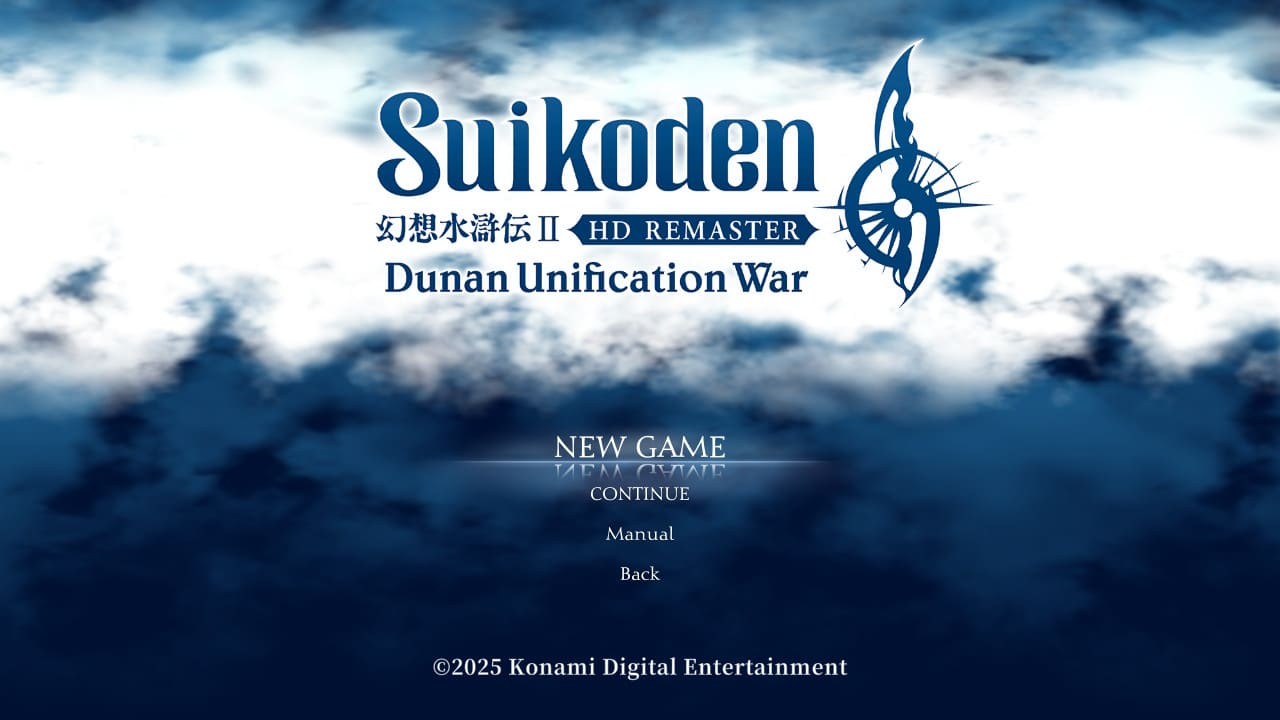
The main menu sets the stage with the iconic logo and calming sky.
Experience
Having just finished Suikoden I HD, I was eager to see how Suikoden II HD would compare—especially with all the praise the sequel has received over the years. While I had always heard about its gripping story and the infamous antagonist, Luca Blight, I never had the chance to play it firsthand. Iconic moments, like the “Die, pig” scene, were familiar to me, but this was my first time experiencing them within the full context of the game.
My history with Konami spans back to playing Bomberman MAX Challenger on my Game Boy Color, followed by deeper experiences with Silent Hill and Metal Gear. However, Suikoden was one franchise I never got around to, despite its reputation. As someone who has played multiple Final Fantasy titles, Shin Megami Tensei games, and the Parasite Eve series, I was curious to see how Suikoden II would stack up against other classic RPGs of its era.
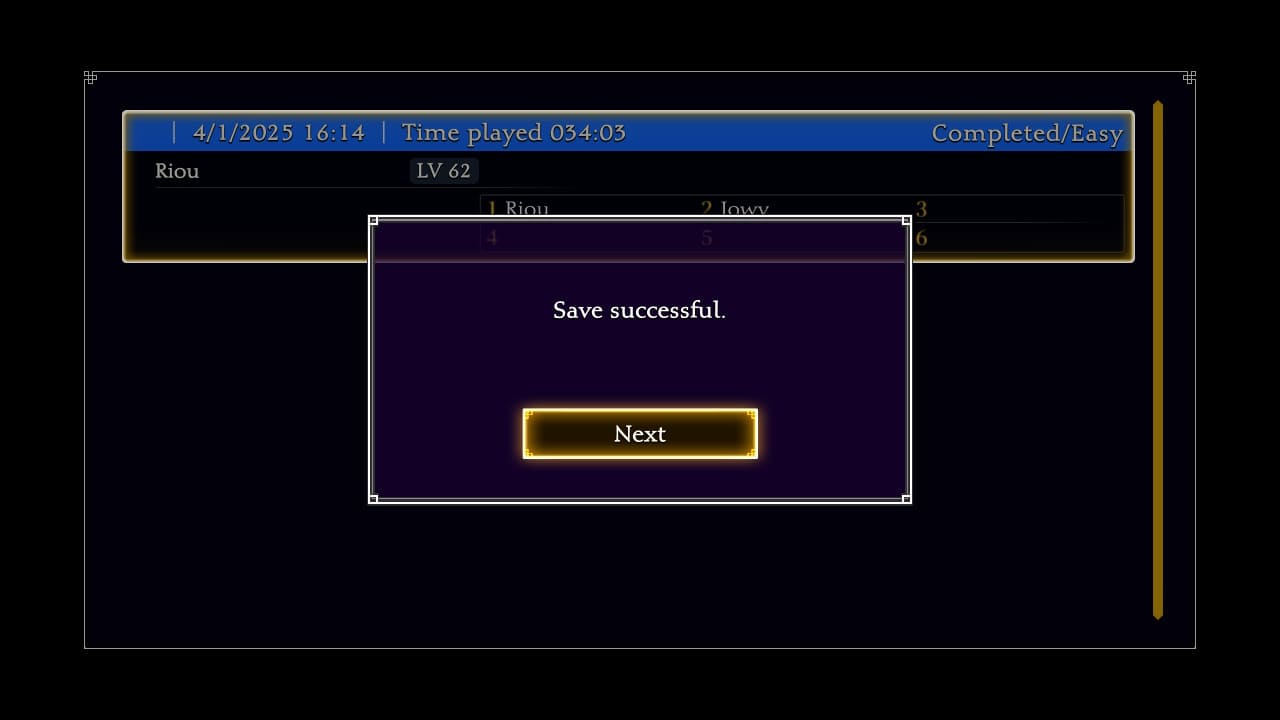
Proof that Suikoden II still knows how to keep you hooked.
Impressions
Introduction
Right from the start, Suikoden II HD sets itself apart with a refined yet familiar presentation. The main menu remains sleek and straightforward, offering options for New Game, Continue, Manual, and a return to the collection’s selection screen.

The main menu sets the stage with the iconic logo and calming sky.
Once the game begins, the shift in tone from its predecessor is immediately apparent. While Suikoden I centered around political upheaval within a crumbling empire, Suikoden II introduces a more personal and emotional conflict, with themes of betrayal, loyalty, and the brutal cost of war. The opening moments quickly immerse you in the escalating tensions between the Highland Kingdom and the City-States of Jowston, setting the stage for one of the most celebrated narratives in RPG history.
Right away, this remaster captures the essence of the original while refining the experience with modern enhancements, making it an inviting entry point for new players and a welcome return for longtime fans.
Gameplay and Mechanics
Suikoden II takes the solid foundation of Suikoden I and refines it with deeper strategic elements and enhancements that elevate the experience. The game introduces several key improvements while keeping the core mechanics intact. Here are the key features and refinements:
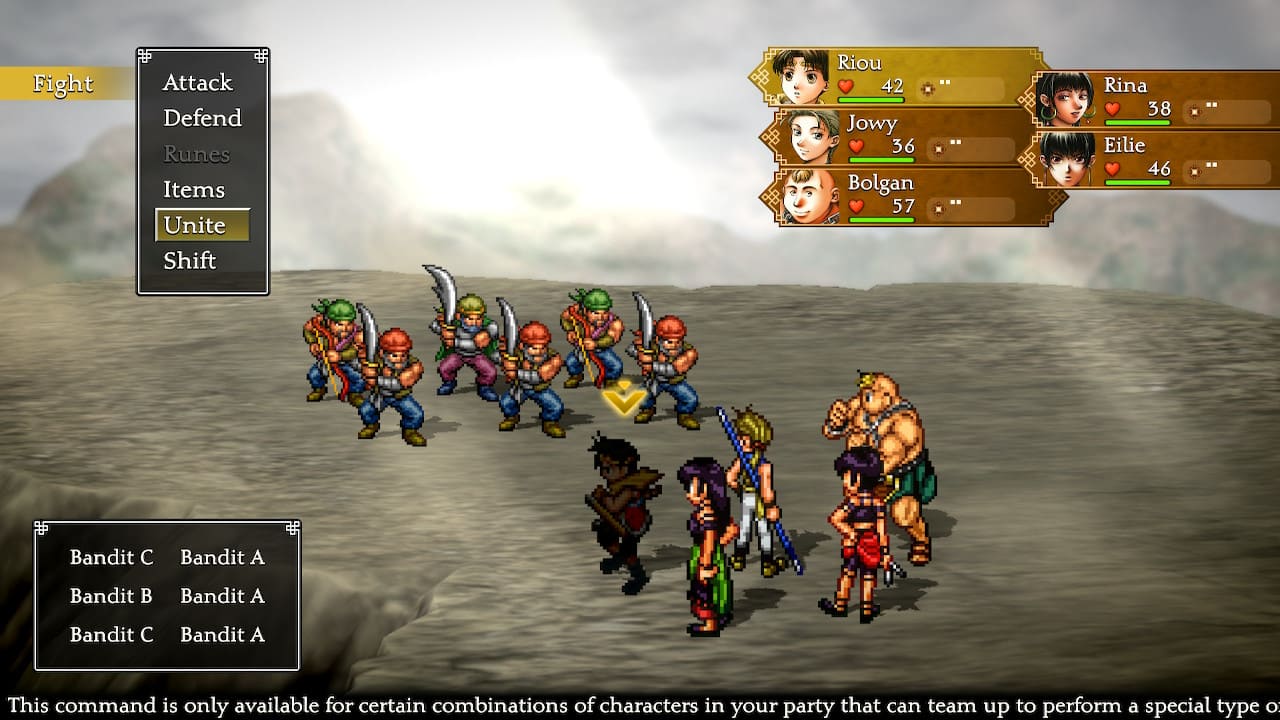
Classic turn-based combat with a familiar crew ready for action.
Front and Back Rows
Suikoden II builds on the front and back row system from Suikoden I, making character placement more important. Certain characters benefit from being in the back for ranged or magic attacks, while others use their positioning to target specific enemy rows, adding more tactical depth.
Weapon Reach
While Suikoden I established weapon reach, Suikoden II enhances it by introducing more weapon types and attack patterns. Some weapons can hit multiple enemies or have other specialized effects, allowing for more strategic choices in combat.
Unity Moves
In Suikoden I, Unite Attacks allowed certain character pairings to perform special moves, but they were fairly limited. Suikoden II expands on this with Unity Moves, which involve more character combinations and are central to combat strategy. These powerful attacks encourage thoughtful party composition and synergy.
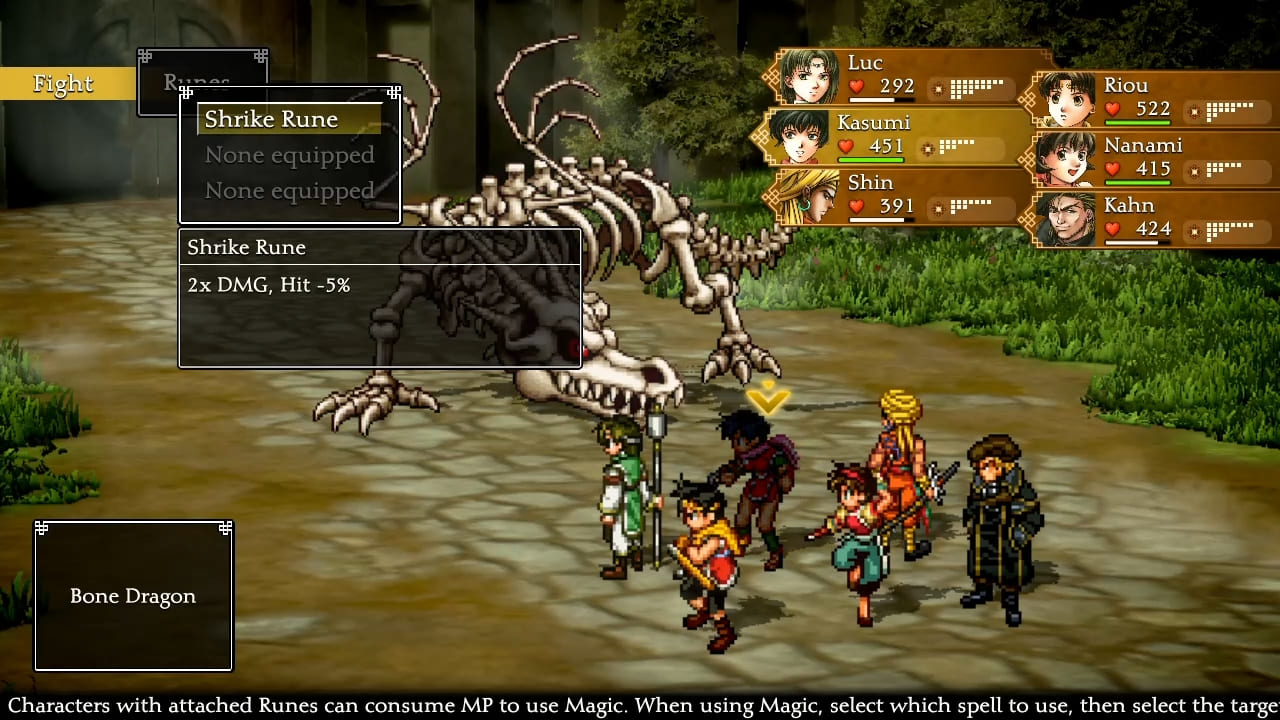
Kasumi’s Shrike Rune adds a sharp edge to this epic battle.
Rune System
Suikoden II takes the Rune System further by offering a wider variety of runes, each with distinct offensive, defensive, and support capabilities. This offers deeper customization, allowing for more tailored strategies and character roles in battle.
Elemental Pieces
Building on the elemental damage concept from the first game, Suikoden II allows you to slot Elemental Pieces into weapons to exploit enemy weaknesses, adding a new layer of strategy in combat.
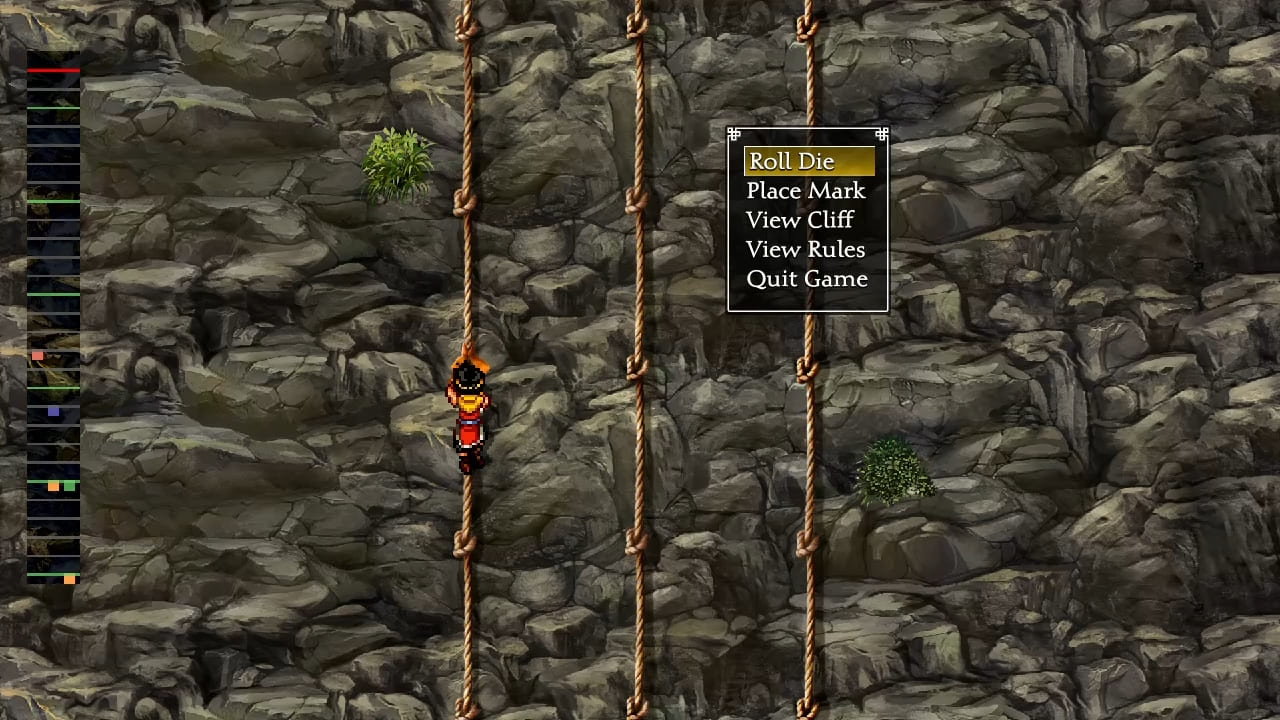
Riou’s climb isn’t just vertical—it’s strategic.
Minigames
Suikoden II expands on Suikoden I‘s minigames, offering more variety like the casino and dueling arena. These activities provide rewards and opportunities to gain experience or valuable items outside of the main story, further enriching the game world.
Art & Audio
The Suikoden II HD Remaster strikes a balance between retaining the original’s charm and modernizing the visual experience. Character portraits have been redrawn by the original artist, Junko Kawano, with some staying true to their original designs, while others receive subtle updates. While this rework can be a mixed bag for long-time fans, those familiar with the game’s original PS1-era portraits might find these changes hit or miss.
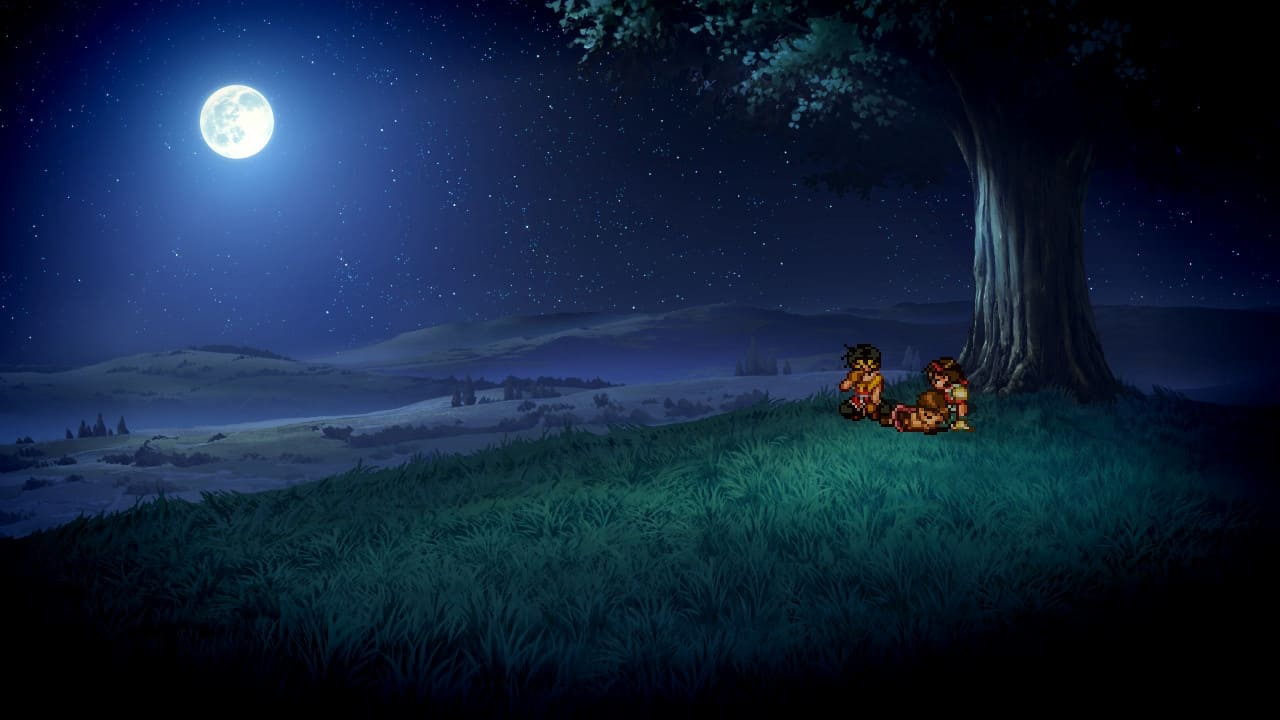
Riou, Nanami, and Maria find peace before the next storm.
The backgrounds in Suikoden II have been fully revamped, offering crisper, more detailed depictions of towns, castles, and dungeons. However, the character sprites remain unchanged, retaining their original pixel art style. This creates a noticeable contrast between the polished environments and the pixelated characters. While it might be initially jarring for new players, I had already grown accustomed to it after finishing Suikoden I HD, and the difference became less noticeable over time.
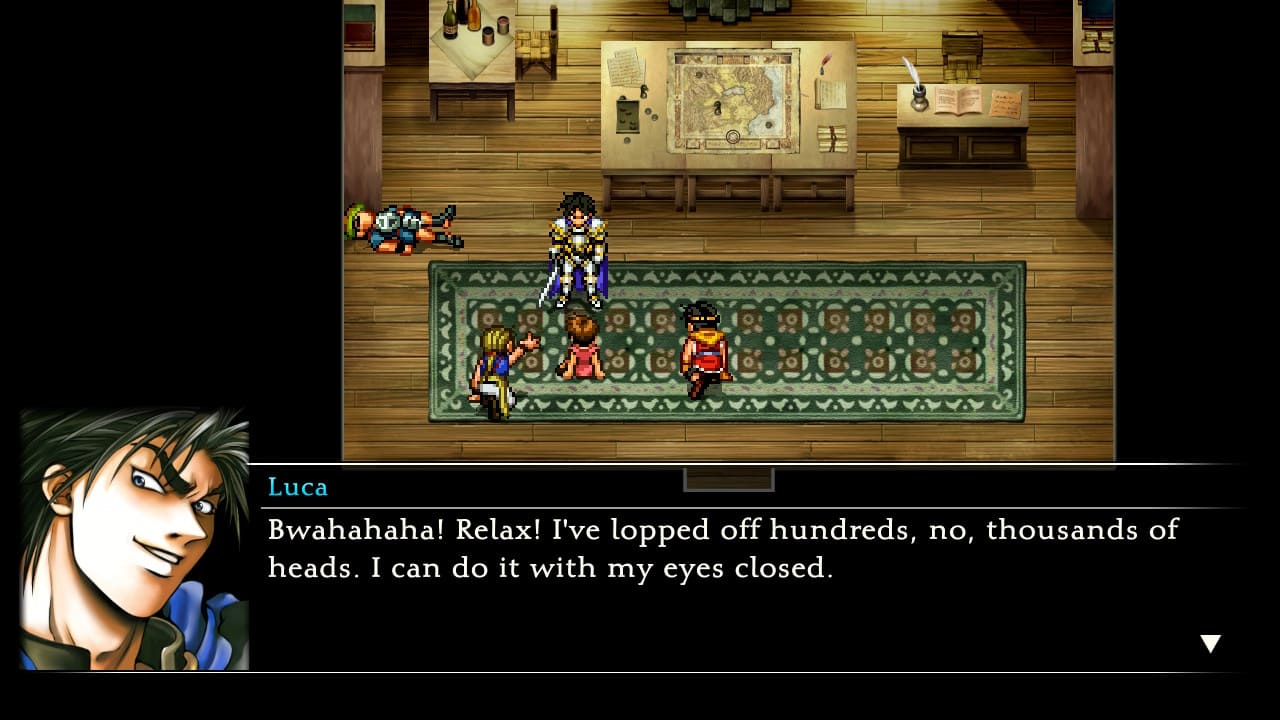
His infamous laugh echoes through the fort as chaos looms.
On the audio front, Suikoden II features a remarkable soundtrack that heightens the game’s atmosphere. Memorable tracks like “Reminiscence – Ensemble Version” underscore the game’s emotional depth with its nostalgic and evocative orchestration.
“Enemy Attack” sets an intense, urgent tone, especially during the early moments when you wake up to the camp on fire.
“The Chase” injects adrenaline into the action, driving the pace during high-stakes, fast-moving moments.
Meanwhile, “Labyrinth” builds an eerie, atmospheric mood as you explore the game’s more foreboding areas.
The sound effects, including sharp sword clashes and ambient sounds, further enhance immersion, adding depth to the overall experience.
Unique Features and Mechanics
The Suikoden II HD Remaster introduces several quality-of-life improvements that make the gameplay experience smoother and more accessible without compromising the essence of the original game. Some of these features include:
Auto-battle Function
Automates repetitive battles, saving time during grinding or easier encounters.
Battle Speed
Players can adjust battle speed with three options for quicker combat.
Updated Save System
Offers both manual and auto-save options for more flexible saving.
Fast Travel
Speeds up navigation across the world, reducing backtracking.
Higher Resolution Support
Improved visuals with sharper backgrounds and menus, while sprites retain their pixelated style.
Enhanced Load Times
Quicker transitions between areas and post-battle, improving flow.
New Trophy / Achievements System
Offers additional challenges and rewards for exploration (Not available on Nintendo Switch).
Cooking Mini-Game
Inspired by Iron Chef, this mini-game features over 50 recipes for healing and stat boosts.
Rune Slot System
Characters now have three rune slots (left hand, right hand, forehead), allowing for more rune magic experimentation in battle.
Catch-Up Leveling System
Party members who fall behind in level receive bonus XP to close the gap, making it easier to keep everyone relevant without excessive grinding.
Story & Writing
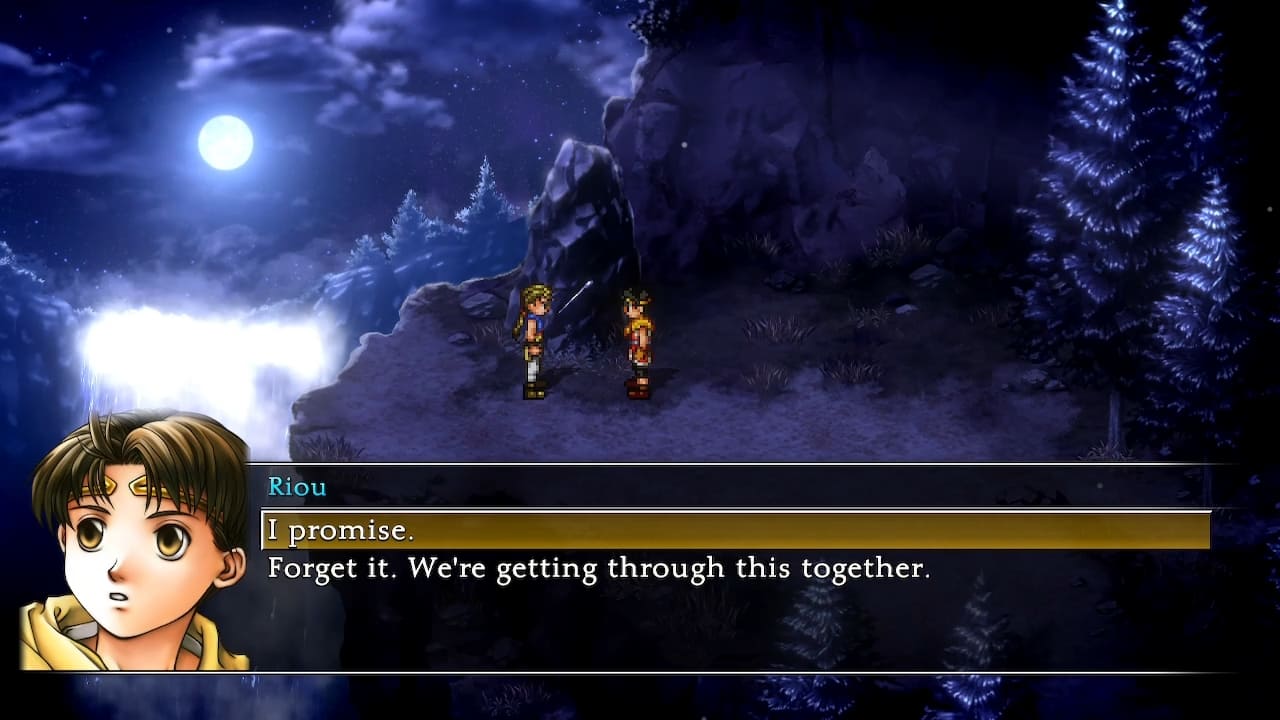
Riou and Jowy vow to return to the waterfall after escaping danger.
Suikoden II builds on the political intrigue and rebellion-driven narrative of its predecessor while deepening the complexity of its world. The story follows the protagonist, who, after witnessing the brutal betrayal and destruction of his homeland, becomes embroiled in a growing resistance against the corrupt Highland Kingdom. Alongside familiar faces from Suikoden I, new characters—each with their own ambitions, backgrounds, and fates—join the cause.
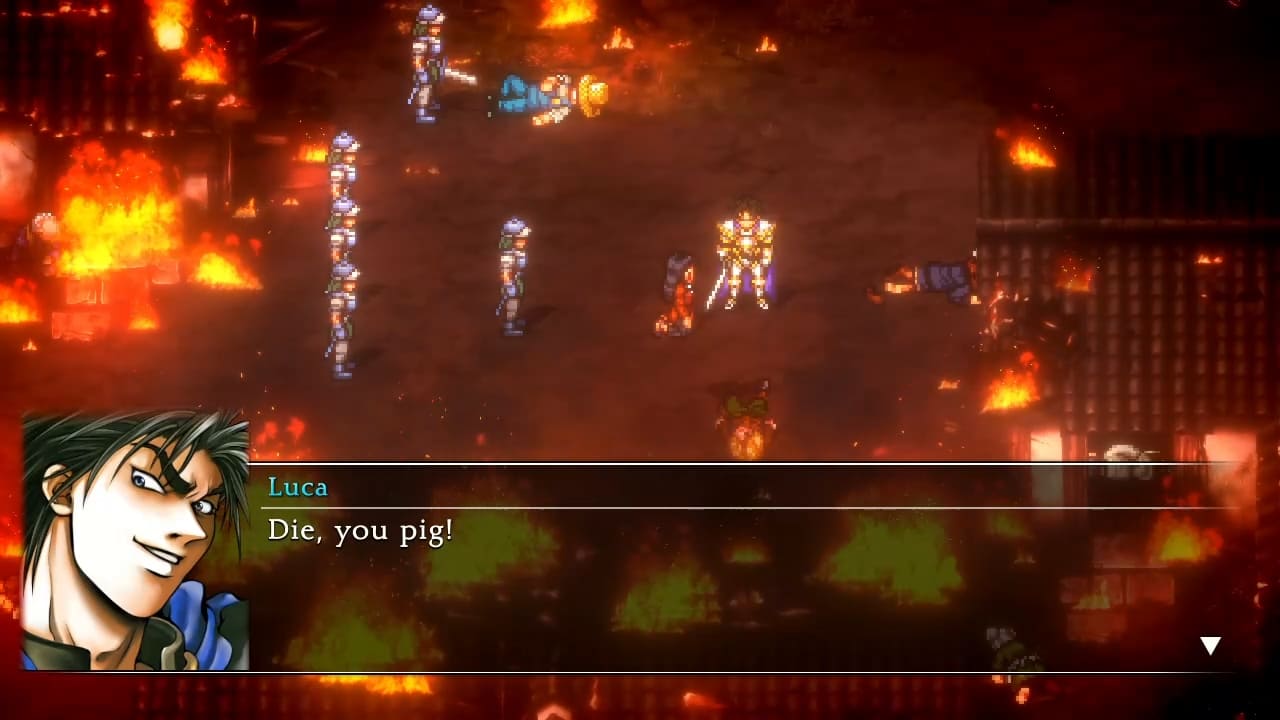
Gregminster burns as chaos unfolds under his blade.
One of the highlights is the development of Luca Blight, one of the series’ most ruthless and memorable villains. His sadistic personality and thirst for war cast a dark shadow over the protagonist’s journey, making him a truly formidable adversary. The emotional stakes of the narrative are amplified by the personal vendettas, alliances, and the looming threat of war that stretches across the land.
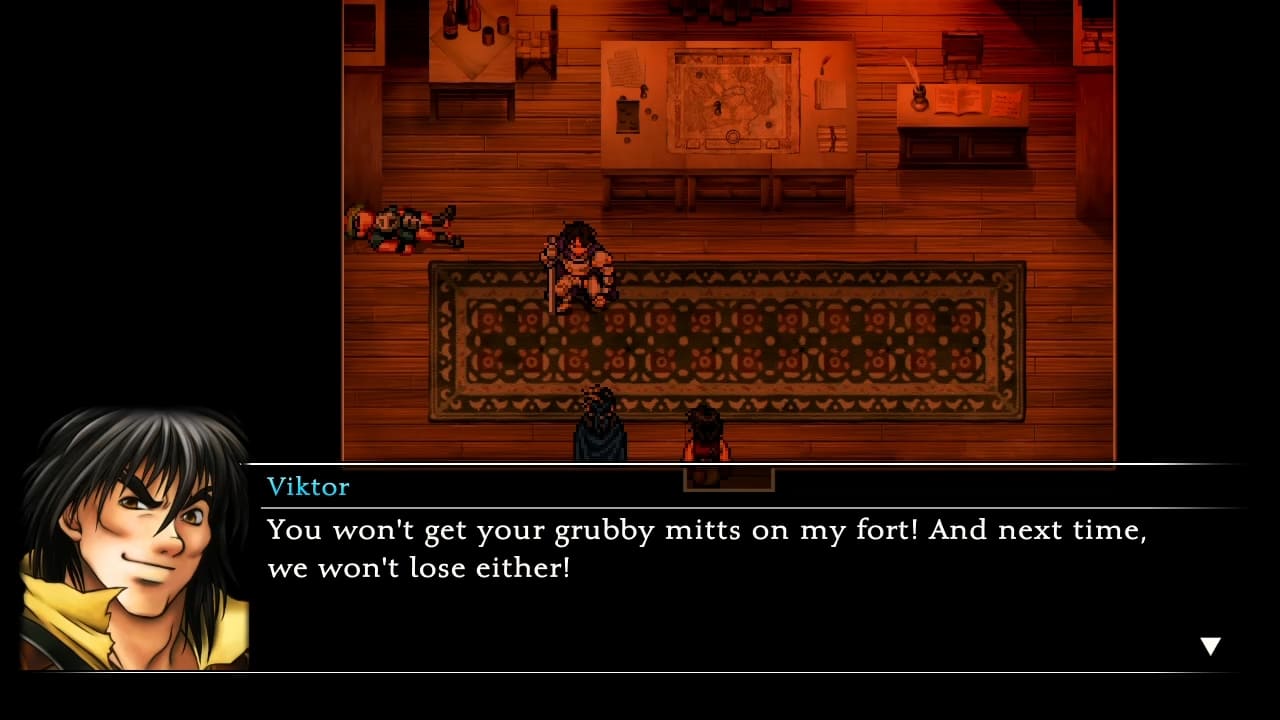
Determined words from a steadfast ally.
In addition to the return of some key characters from the original Suikoden, the sequel provides deeper development for those who may not have had the spotlight before. While certain figures from the first game are featured more prominently, others now get their chance to shine, enriching the overall tapestry of the story. These returning characters contribute to a more fleshed-out narrative that not only honors their original appearances but expands their roles in unexpected ways.
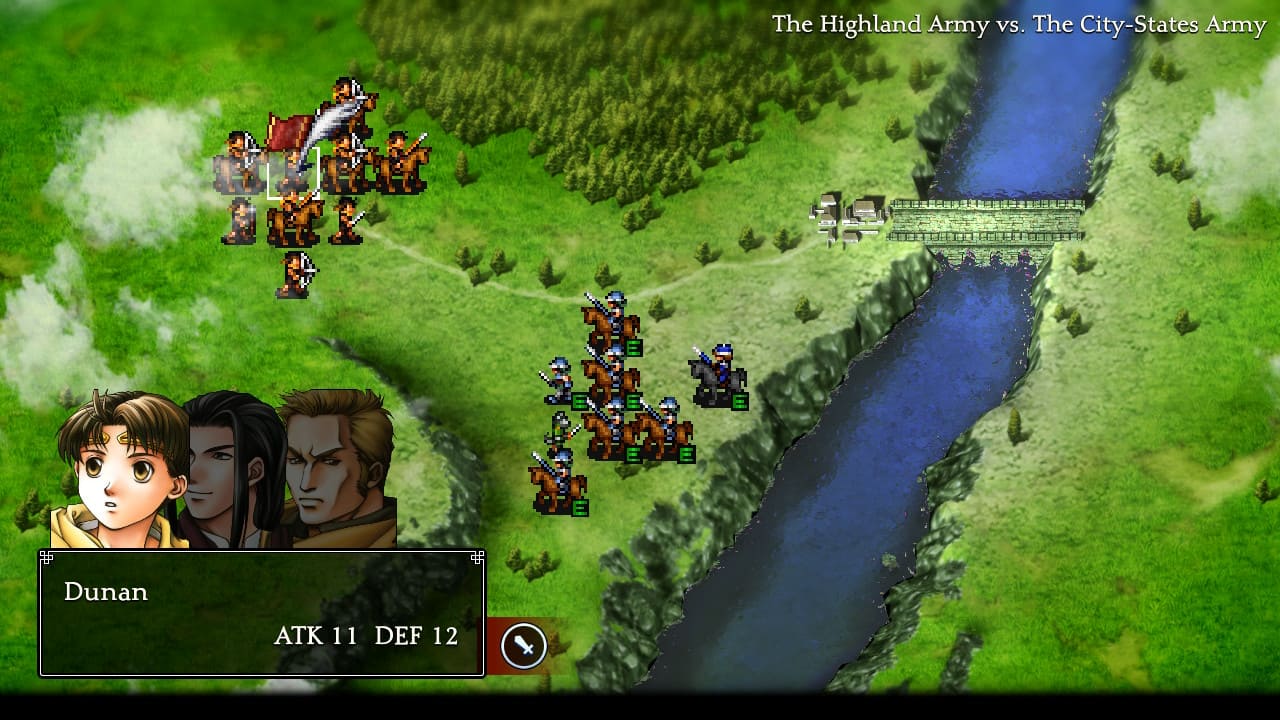
The Dunan forces face off in a tense War Battle.
A significant gameplay change in Suikoden II is the evolution of War Battles, which move away from the simplified Rock-Paper-Scissors mechanic of the first game to a more sophisticated, tactical system reminiscent of SRPGs like Fire Emblem. These battles are crucial to the progression of the story and can even lead to the permanent death of characters, depending on the player’s decisions during the conflict.
The ability to position units, assign commanders, and use special strategies adds a layer of depth that makes the War Battles central to both the gameplay experience and narrative outcomes. The consequences of these battles are not merely mechanical; they can drastically affect the story’s course and the fate of key characters.
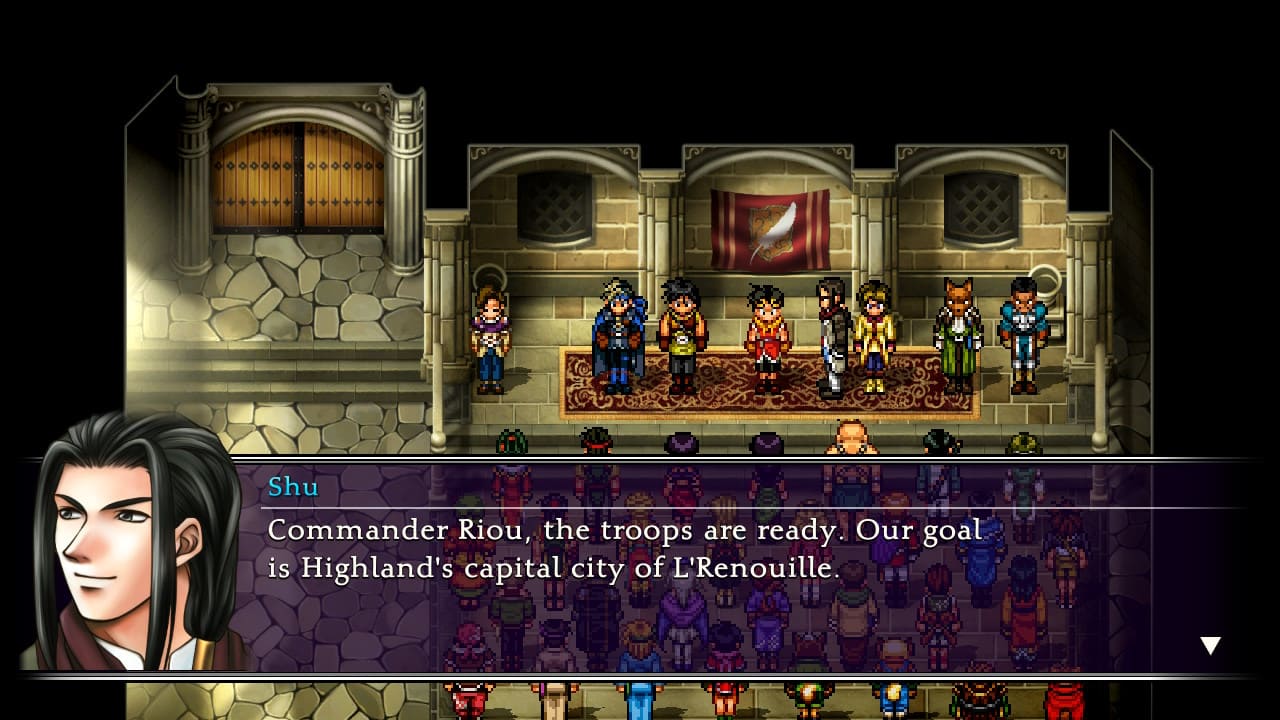
Shu rallies the forces before the capital city assault.
Overall, the writing in Suikoden II excels in blending personal character arcs with the broader political and military drama. The narrative is rich with layers of betrayal, sacrifice, and ambition, while the deeper integration of War Battles ensures that each victory and loss feels weighty and consequential.
Verdict
The Suikoden II HD Remaster revitalizes a classic RPG with stunning modernized visuals, refined gameplay, and thoughtful quality-of-life improvements. Redrawn backgrounds and a sleek menu system enhance the visual experience, while the streamlined mechanics—like fast travel, auto-battle, an updated save system, and the innovative catch-up leveling system—make progression smoother and more accessible without sacrificing the game’s strategic depth.
The combat remains as engaging as ever, with Unity Moves, elemental customization, and rune-based abilities offering layers of tactical options, keeping each encounter fresh. The reworked translation breathes new life into the story, restoring subtle nuances and improving dialogue flow, making the gripping tale of rebellion, political intrigue, and high-stakes drama even more impactful.
For a first-time player, Suikoden II offers stakes that feel genuinely high—especially with Luca Blight’s villainy and the constant threat of entire towns being reduced to ashes. The emotional investment this game demands is rare in RPGs, making it an unforgettable journey.
It’s no wonder why Luca Blight is regarded as one of the best villains in gaming. In an era of overly sympathetic antagonists, his portrayal is a refreshing reminder of how compelling and menacing a villain can be.
With the perfect balance of respecting its legacy and offering meaningful improvements, this remaster is a masterpiece in its own right. Whether you’re a newcomer or a longtime fan, Suikoden II remains a must-play RPG, and this remaster is an essential upgrade to experience it at its finest.
TLDR
Suikoden II HD Remaster (Switch)
10
Masterpiece
Summary: Suikoden II HD Remaster successfully brings a beloved classic into the modern era, preserving its core experience while enhancing visuals, gameplay, and overall performance. The updated translation deepens the story’s political intrigue and rebellion, making an already compelling narrative even more impactful. The remaster strikes a perfect balance, offering both new players and longtime fans a refined, accessible experience that stays true to the original.
While minor issues like the auto-save system and manual adjustments for auto-battle exist, they don’t detract from the game’s brilliance. A perfect example of how a remaster should be done, this is a must-play for both newcomers and dedicated fans alike.
References
- Szczepaniak, J. (2024, February 23). The making of: Suikoden II, a JRPG to match “Game of thrones” in intrigue and impact. Time Extension.
- Brown, M. (2019, October 19). Yoshitaka Murayama Email.
- Suikoden 2 OST – Reminiscence – Emsemble Version
- OST SUIKODEN 2 – ENEMY ATTACK
- Suikoden II OST – The Chase
- OST SUIKODEN 2 – Labyrinth


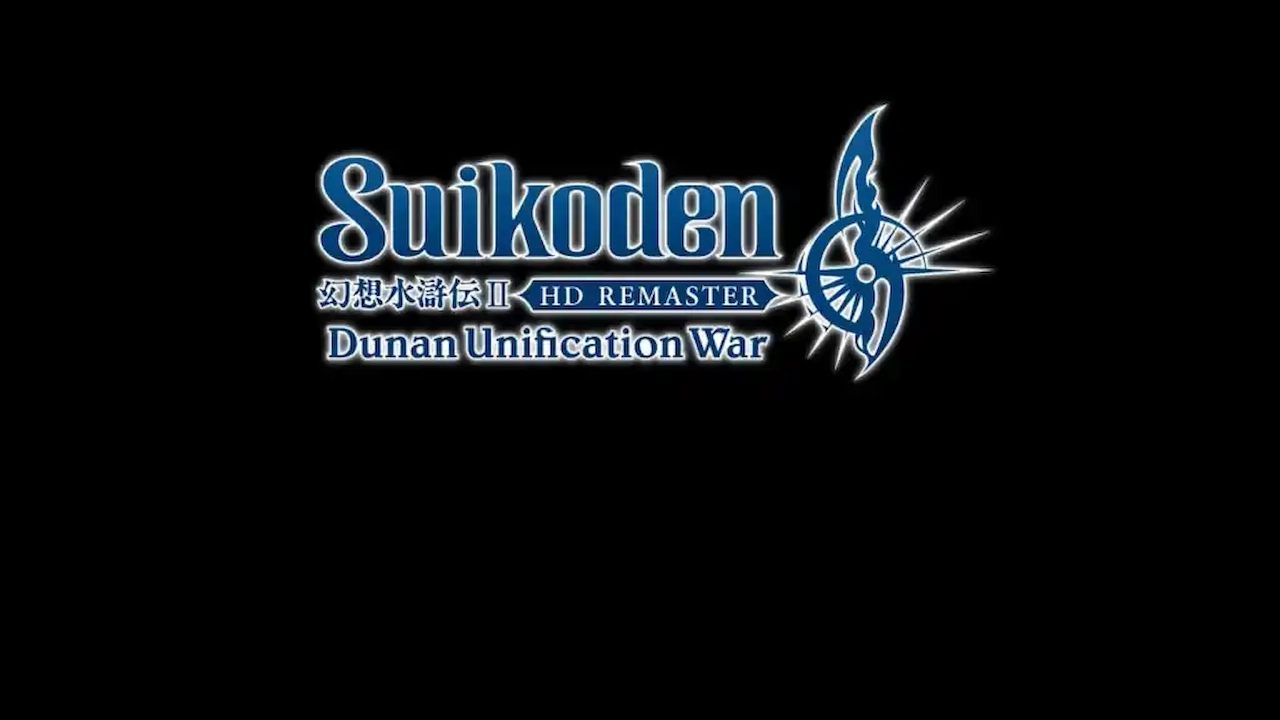
Leave a Reply